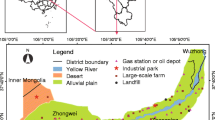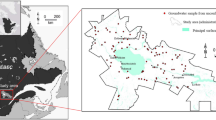Abstract
The texture and three-dimensional framework of geologic materials should be considered in assessments of groundwater's vulnerability to contamination because geology controls the movement of contaminants and groundwater and influences groundwater quality. Contaminants are introduced into, transmitted through, and stored by geologic materials. We present a model that identifies aquifers and ranks sequences of geologic materials by their relative potential for transmitting water and contaminants from land surface. With this basis, the model can be used to assess the potential for contamination of aquifers by surface activities such as landfitling of wastes or application of agricultural chemicals. A regional map of aquifer contamination potential can be generated from the model; it retains the geologic map information intact and available for reinterpretation or other uses.
The model was developed using broad, regional map information and is intended to be a general tool for assessing the regional vulnerability of aquifers to contamination. It is not intended for local, site-specific use, but for prioritizing local areas where contamination potential and/or land-use history warrant more detailed assessment or monitoring. Because it provides a regional view of contamination potential, regional patterns or trends of map units should be evaluated, rather than using the map information literally to assess local areas. Methods of applying this model and contamination potential map to groundwater protection and management are currently being studied; research includes an attempt to statistically validate the model with water-quality data, and to identify natural groupings of the ranked contamination potential map units.
Similar content being viewed by others
References Cited
Aller, L., T. Bennett, J. H. Lehr, R. J. Petty, and G. Hackett, 1987, DRASTIC; A standardized system for evaluating ground water pollution potential using hydrogeologic settings: U.S. Environmental Protection Agency, EPA/600/2-87/035, 622 p.
Berg, R. C., and J. P. Kempton, 1984, Potential for contamination of shallow aquifers from land burial of municipal wastes: Champaign, Illinois, Illinois State Geological Survey map, scale 1:500,000.
Berg, R. C., J. P. Kempton, and K. Cartwright, 1984a, Potential for contamination of shallow aquifers in Illinois: Illinois State Geological Survey Circular 532, 30 p.
Berg, R. C., J. P. Kempton, and A. N. Stecyk, 1984b, Geology for planning in Boone and Winnebago Counties: Illinois State Geological Survey Circular 531, 69 p., map scale 1:62,500.
Cartwright, K., and B. R. Hensel, in press, Chapter 4, Hydrogeology;in D. E. Daniel, ed., Geotechnical practice for waste disposal: New York, Chapman and Hull.
Ertel, M., 1990, Information exchange on models and data needs relating to the impact of agricultural practices on water quality: Workshop proceedings: U.S. Geological Survey Office of Water Data Corrdination, cosponsored by U.S. Geological Survey, Agricultural Research Service, and Soil Conservation Service, Reston, Virginia, 2/5–8/90, 217 p.
Freeze, R. A., and J. A. Cherry, 1979, Groundwater: Englewood Cliffs, New Jersey, Prentice-Hall, 604 p.
Keefer, D. A., and R. C. Berg, 1990, Potential for aquifer recharge in Illinois: Illinois State Geological Survey map, scale 1:1,000,000.
Kolpin, D. W., and M. R. Burkart, 1989, Indicators of pesticides in shallow aquifers in Iowa: U.S. Geological Survey Open-file 89-409, p. 47.
Passero, R. N., F. J. Cohen, S. J. Dulaney, J. McNamara, and S. E. Benton, 1989, Determining the vulnerability of glacial drift aquifer systems in Michigan [abst.]: 34th Annual Midwest Groundwater Conference, Program with abstracts, October 18–20, 1989, Kalamazoo, Michigan, p. 8.
Schmidt, R. R., and K. Kessler, 1987, Groundwater contamination susceptibility in Wisconsin (a map in: Report No. 5—Groundwater contamination susceptibility map and evaluation): Wisconsin Department of Natural Resources, Wisconsin's groundwater management plan, report no. 5, scale 1:1,000,000.
Soller, D. R., in press, Map showing the thickness and character of Quaternary sediments in the glaciated United States east of the Rocky Mountains: U.S. Geological Survey Miscellaneous Investigations Series Map I-1970-A, -B,-C, -D, scale 1:1,000,000.
U.S. Environmental Protection Agency, 1984, Ground-water protection strategy: Office of Ground-Water Protection, 55 p.
Author information
Authors and Affiliations
Rights and permissions
About this article
Cite this article
Soller, D.R., Berg, R.C. A model for the assessment of aquifer contamination potential based on regional geologic framework. Environ. Geol. Water Sci 19, 205–213 (1992). https://doi.org/10.1007/BF01704087
Issue Date:
DOI: https://doi.org/10.1007/BF01704087




